Semantic Web
> Skac
Smart Data News, Articles, & Education Archives.
Standards
Datasets. LOD Cloud 2014. Software. Semantic Technologies, Linked Open Data. DBpedia Ontology. Semantic-mediawiki.org. OWL 2 Web Ontology Language Primer (Second Edition)
Semantic University. Semantic University is the largest and most accessible source of educational material relating to semantics and Semantic Web technologies.

It includes: Lessons suitable to those brand new to the space.
Untitled. Part I.
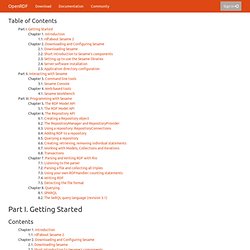
Getting Started Chapter 1. Introduction. OpenRDF.org: Home. Mereology. Mereology has been axiomatized in various ways as applications of predicate logic to formal ontology, of which mereology is an important part.

A common element of such axiomatizations is the assumption, shared with inclusion, that the part-whole relation orders its universe, meaning that everything is a part of itself (reflexivity), that a part of a part of a whole is itself a part of that whole (transitivity), and that two distinct entities cannot each be a part of the other (antisymmetry). A variant of this axiomatization denies that anything is ever part of itself (irreflexive) while accepting transitivity, from which antisymmetry follows automatically. Standard university texts on logic and mathematics are silent about mereology, which has undoubtedly contributed to its obscurity. History[edit] A.N. In 1930, Henry Leonard completed a Harvard Ph.D. dissertation in philosophy, setting out a formal theory of the part-whole relation. Axioms and primitive notions[edit] The axioms are:
Semantic network. Typical standardized semantic networks are expressed as semantic triples.
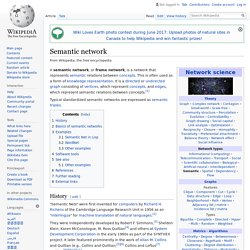
History[edit] Example of a semantic network. YAGO - D5: Databases and Information Systems (Max-Planck-Institut für Informatik)
Overview YAGO is a huge semantic knowledge base, derived from Wikipedia WordNet and GeoNames.
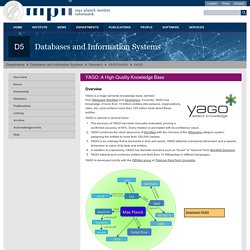
Currently, YAGO has knowledge of more than 10 million entities (like persons, organizations, cities, etc.) and contains more than 120 million facts about these entities. YAGO is special in several ways: The accuracy of YAGO has been manually evaluated, proving a confirmed accuracy of 95%. Every relation is annotated with its confidence value.YAGO combines the clean taxonomy of WordNet with the richness of the Wikipedia category system, assigning the entities to more than 350,000 classes.YAGO is an ontology that is anchored in time and space. YAGO is developed jointly with the DBWeb group at Télécom ParisTech University.
Word2vec - Tool for computing continuous distributed representations of words.
Mappings.dbpedia.
Freebase. Freebase is a large collaborative knowledge base consisting of metadata composed mainly by its community members.

It is an online collection of structured data harvested from many sources, including individual 'wiki' contributions.[2] Freebase aims to create a global resource which allows people (and machines) to access common information more effectively. It was developed by the American software company Metaweb and has been running publicly since March 2007. Metaweb was acquired by Google in a private sale announced July 16, 2010.[3] Google's Knowledge Graph is powered in part by Freebase.[4] Freebase data is freely available for commercial and non-commercial use under a Creative Commons Attribution License, and an open API, RDF endpoint, and database dump are provided for programmers.
Overview[edit] Described by Tim O'Reilly upon their launch, "Freebase is the bridge between the bottom up vision of Web 2.0 collective intelligence and the more structured world of the semantic web. Visual Data Web - Visually Experiencing the Data Web. About. Five AKSW Papers at ESWC 2014 Hello World!
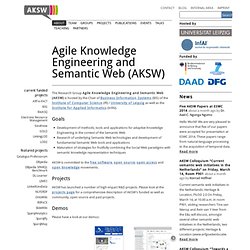
We are very pleased to announce that five of our papers were accepted for presentation at ESWC 2014. These papers range from natural-language processing to the acquisition of temporal data. Read more about "Five AKSW Papers at ESWC 2014"
Semantic University. Semanticweb.com - The Voice of Semantic Web Business. Scardf - Scala RDF API. SweoIG/TaskForces/CommunityProjects/LinkingOpenData - W3C Wiki. News 2014-12-03: The 8th edition of the Linked Data on the Web workshop will take place at WWW2015 in Florence, Italy.
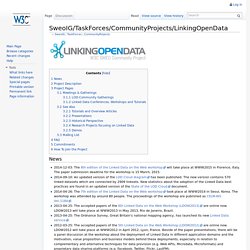
The paper submission deadline for the workshop is 15 March, 2015. 2014-09-10: An updated version of the LOD Cloud diagram has been published. The new version contains 570 linked datasets which are connected by 2909 linksets. New statistics about the adoption of the Linked Data best practices are found in an updated version of the State of the LOD Cloud document. 2014-04-26: The 7th edition of the Linked Data on the Web workshop took place at WWW2014 in Seoul, Korea.
SemWebCentral. Semanticweb.org. LDIF – Linked Data Integration Framework. CubicWeb - The Semantic Web is a construction game! — CubicWeb 3.14.4. About WordNet - WordNet - About WordNet. RDF/OWL Representation of WordNet. Abstract This document presents a standard conversion of Princeton WordNet to RDF/OWL.
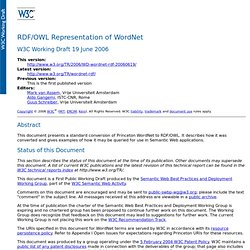
It describes how it was converted and gives examples of how it may be queried for use in Semantic Web applications. Status of this Document This section describes the status of this document at the time of its publication. Other documents may supersede this document.
Synonym - WordNet visualization using Force-Directed Graphs. Welcome to the UMBEL Web Site !
Linked data. An introductory overview of Linked Open Data in the context of cultural institutions.

In computing, linked data (often capitalized as Linked Data) describes a method of publishing structured data so that it can be interlinked and become more useful. It builds upon standard Web technologies such as HTTP, RDF and URIs, but rather than using them to serve web pages for human readers, it extends them to share information in a way that can be read automatically by computers. This enables data from different sources to be connected and queried.[1] Tim Berners-Lee, director of the World Wide Web Consortium, coined the term in a design note discussing issues around the Semantic Web project.[2]
Jena - Welcome to Jena. Web Ontology Language. Istnieją trzy odmiany języka OWL: OWL Lite;OWL DL (rozszerzenie OWL Lite);OWL Full (rozszerzenie OWL DL). OWL został uznany w lutym 2004 roku za standard przez W3C. RDF i OWL są bardzo podobne i dotyczą tego samego problemu, jednak OWL jest językiem bardziej rozbudowanym, z większym słownikiem i mocniejszą składnią.
OWL Web Ontology Language Overview. W3C Recommendation 10 February 2004. OWL Web Ontology Language Guide. W3C Recommendation 10 February 2004 New Version Available: OWL 2 (Document Status Update, 12 November 2009) The OWL Working Group has produced a W3C Recommendation for a new version of OWL which adds features to this 2004 version, while remaining compatible.
Please see OWL 2 Document Overview for an introduction to OWL 2 and a guide to the OWL 2 document set. This version:
SemanticWebTools - W3C Wiki. REDIRECT New SemanticWiki Tools Page As of 12:50, 14 January 2010, this page is no longer maintained and should not be changed. The content has been transferred to (Changes made here after the above date may not be reflected on the new page!) Please consult and possibly modify that page.
Tools. This page gives an overview of software tools related to the Semantic Web or to semantic technologies in general. Due to the large amount of tools being created in the community, this site is always somewhat outdated. Contributions and updates are welcomed. See also: Tool Chains Adding your own Adding your own tool is as easy as creating a page.
Sig.ma EE- Semantic Information Mashup Enterprise Edition.
About. DBpedia is a crowd-sourced community effort to extract structured information from Wikipedia and make this information available on the Web. DBpedia allows you to ask sophisticated queries against Wikipedia, and to link the different data sets on the Web to Wikipedia data.
Tools - Visual Data Web. Resource Description Framework. RDF Primer.










